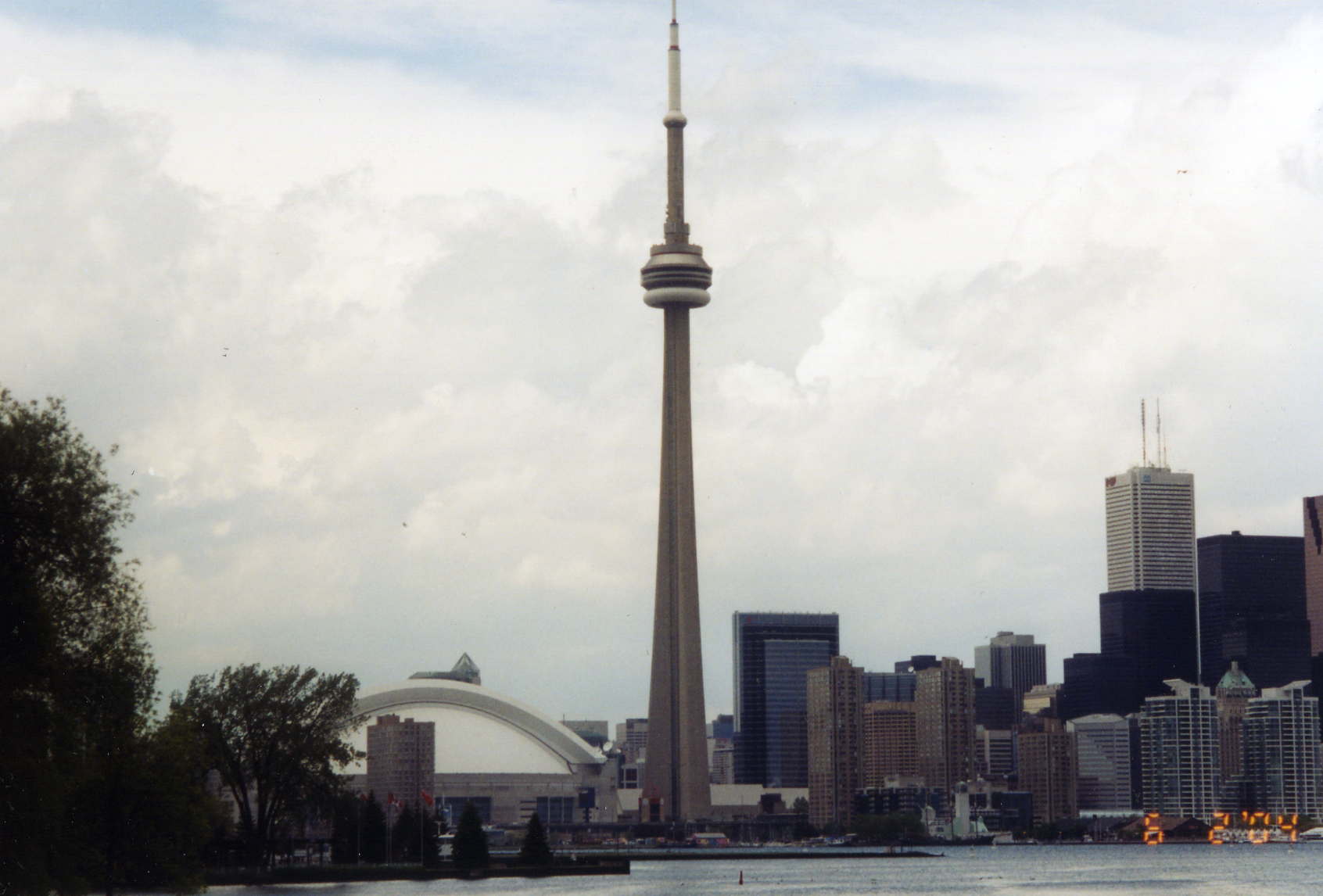| Taking tentative steps into the center of town, I was greeted by a cacophony of tongues, some familiar, some not, all proclaiming that Toronto is indeed "the world within a city". Toronto lies on the northern banks of Lake Ontario, the smallest of the Great Lakes. The visitor is at once drawn to the lake and Toronto Islands, a short ferry hop from Harbourfront. Standing on the bow of the ferry, I watched some ducks waddling along, like a chorus line of some sort, directly ahead of us. When the boat blew its horn, they broke ranks and flew in all directions only to return shorly thereafter, oblivious of danger. Suddenly I saw lightning strikes in the distant skiy and I moved to safety. From my new vantage point, I could see CN Tower punctuating the Toronto skyline. Sky Dome, home of the Blue Jays, looked like a perfectly inflated balloon. It was quiet in the islands and park was nearly emply this early in the summer season. I would have loved to walk from one island to the other then catch the next ferry to town, but the weather was uncooperative. We saw Gibraltar Lighthouse, freshly painted in read and white, peeping through some trees. This is the oldest monument in the city that is still standing on the same spot. Casa Loma (House on the Hill) is one of the most interesting landmarks in Toronto. It was built in 1911 at a cost of $3.5 million for Sir Henry Mill Pellatt, financier, industrialist, military officer and knight. He lived in this castle for nine years until he lost his fortune and the government took his house as payment for back taxes. There are 98 rooms in the house, some of which are beautifully appointed in original furniture. The five-acre garden, which is carefully tended to by a staff of gardeners, is a pictorial attraction. An 800-foot tunnel connects the house to the stables on the other side of the street. Like the main house, the stables have imposing medieval towers. It's not difficult to imagine the pain Sir Henry must have felt in losing his castle. But the realization that none of his so-called friends were there to help him after the parties ended, must have proven more agonizing. Luckily for him, he had a loyal chauffeur at whose house he spent the rest of his days. Exploring Toronto on foot is the best way to get the feel of the city. A good starting point is at Nathan Phillips Square in front of the new City Hall. Office workers in the area eat their lunch while enjoying the view of fountains and the circular council chamber resting in the middle of two facing, curved towers of differing heights. What a contrast to the heavy, stone structure of the Old City Hall nearby! The statue of Winston Churchill on the square is a show stopper. Now what can he be thinking of with that angry look on his face? Continuing on Queen Street you pass Osgoode Hall, former home of the Supreme Court. Around the corner is University Avenue, a tree-lined thoroughfare leading to Queen's Park where the Ontaio Legislature and the University of Toronto are located. Notice the caricatures carved on the legislative building. Walking south on University from Queen's Park, make a right on Dundas Street. The Art Gallery of Ontario (AGO) boasts one of the largest collections of works by the British sculptor, Henry Moore. "Two Large Forms", a Moore sculpture, is installed in front of the museum. There is also a fine collection of European art including a rare Rembrandt, "Portrait of a Lady with a Lap Dog", 1665. This is a painting of Rembrandt's daughter-in-law in elegant finery. Not to be missed are works by Canadian artists like William Blair Bruce's "Landscape with Poppies", 1881. Children will be awed by the dinosaur exhibits at the Royal Ontario Museum (ROM) and perhaps feel a little frightened by the thousands of bats in the bat cave, a replica of St. Clair cave in Jamaica. Thankfully, the bats only look menacing. ROM offers a diverse collection of objects from Art and Archaeology to Science and Nature. I personally enjoyed the period furniture collection including some beautiful art deco pieces. A visit to Toronto would not be complete without "going under". The underground city is especially a blessing during winter months when it's biting cold outside. There are 27 kilometers (16.7 miles) of passageways known as PATH below street level in the downtown area with shops, restaurants and services. These walkways saved me from getting soaked by intermittent rains during my visit. The Huron people gave Toronto its name. It means "meeting place". And from Chinatown to Little Italy, Portugal Village to Kensington Market and the dual language system (French and English), we are reminded again and again that many cultures are gathered in Toronto, giving shape to "the world within a city". * * * Getting around: Toronto has a simple subway going north and south, east and west. It stops close to most tourist landmarks such as Casa Loma (Dupont stop),Royal Ontario Museum (Museum), AGO (St. Patrick). Where to stay: The Toronto Hilton is conveniently located in the center of town, one block from the subway and City Hall. Their number is 416/869-3456 or reserve online at www.hilton.com. |
| Toronto - "The Meeting Place" by Rosario Albar |
| Skydome and CN Tower |
| Published in the Manila Bulletin USA July 15-21, 2004 issue. |
 |

